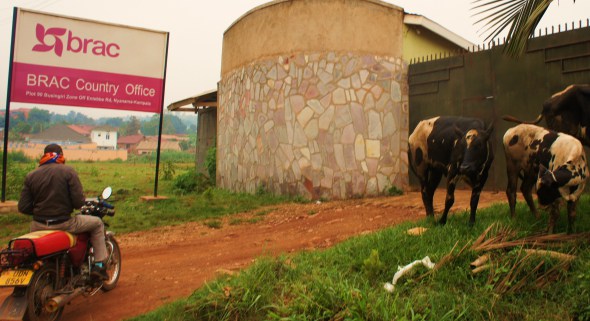The Ultra Poor: BRAC’s tool in Combating Poverty
By Ava Ikbal
Contributor
Nearly 1 billion live in poverty lacking access to clean water, education, sanitation, good nutrition, etc. Additionally, 36% of the population live in extreme poverty. “The World Bank defines extreme poverty as an income below a poverty line of $1.25 per day, measured in US dollars at international prices by 2005.” (Sachs, 2015) However, a World Bank study divided part of the extreme poor into another group: the ultra-poor. (World Bank, 1998) BRAC, one of the biggest nongovernmental organizations in Bangladesh, especially shifted their focus towards the ultra-poor because it is a prevalent group among Bangladeshi villages. The ultra-poor consist of a destitute group of people who are trapped in poverty and left behind by development and health advancements. Author Ian Smillie even described the ultra-poor as “people so poor, so weighed down by ignorance, ill health and fear, that they were unable to join a BRAC group or any other.” (BRAC, 2013) After BRAC attempted to use tools such as microfinance and legal rights targeted towards the ultra-poor, they realized these methods often failed to reach the ultra-poor as they were at the bottom of the ladder. (BRAC, 2013) By making that clear distinction between methods used for the extreme poor versus the ultra-poor, tools can be specialized in targeting the key issues that affect the ultra-poor and help them fight out of poverty. Furthermore, organizations such as BRAC have been working on these specialized interventions that improve development policy specifically for the ultra-poor.
Known as a multi-dimensional issue, poverty cannot be measured by only one factor. While the World Bank poverty line is basically created from income, it fails to recognize the multi-dimensional factors that realistically affect poverty such as access to clean water, literacy rates, sanitation, etc. The Journal of International Development states three possible approaches to identify poverty which include a direct method using information on calorie consumption, an indirect method using data on income/expenditure, and a qualitative method using the perception of the respondents. (Halder & Mosley, 2004) However, without a recognized definition or ways to identify the ultra-poor group, it makes it harder to recognize how exactly a group is categorized as ultra-poor. While there isn’t a universally recognized classification, the most commonly used definition comes from the World Bank as those who have no land or house of their own, sell manual labor with no other means of income, have no savings, are unable to have three meals a day, cannot afford to purchase minimum clothing, and have no ability to spend money on education. (World Bank, 1998) According to a 2007 report from International Food Policy Research Institute based on 2004 data, about 162 million people live in ultra-poverty, defined as living on less than 50 cents a day.” (BRAC, 2013) Stuck in a trap and living on about 60 cents a day, the ultra-poor seem to be stuck in poverty and only specific and hands-on techniques can help this group break out of their trap.
The extreme poor is not a homogenous group and cannot be treated all the same. Part of the extreme poor is the ultra-poor and this group needs specific methods of poverty alleviation as the ultra-poor often do not benefit from market-based interventions like microfinance. (BRAC, 2013) Whereas groups like Grameen Bank provide micro-loans to communities in extreme poverty to help them invest in their proposed businesses, the ultra-poor may not always be able to benefit from these loans.“ Although microfinance is targeted to the poor, the ultra-poor, lacking in livelihood resources are reluctant to borrow with fear of being overburdened, and indeed have a fear of the cash economy.” (Halder & Mosley, 2004) Where in most cases of alleviating poverty, microfinance seems to be one of the best options, this may not necessarily be the case when regarding the ultra-poor.
This is why BRAC has come up with the “graduation” program to implement amongst the ultra-poor. This program uses tools such as proper targeting, grants of productive assets, weekly stipends, savings, intensive hands-on training, health care, and social integration to assist communities to “graduate” out of ultra-poverty. After groups of 40 to 50 villagers rank the wealth of households in a specific village, the households are given productive assets such as livestock to create a living. (BRAC, 2013) Additionally, with training on how to utilize their livestock and generate an income from it, they can re-unite with the community in a healthy and economic way. Social integration is especially crucial because it allows women to be re-integrated into the community which gives them a sense of confidence that they need to “graduate.” One woman from this “graduation” program said that, “People invite me to their houses, because they see that things have changed for me.” (BRAC, 2013) Modeled after this “graduation” approach, other organizations such as CGAP and the Ford Foundation have used similar methods to target the ultra-poor in other developing countries. After 18 to 36 months of implementing these programs, 75% to 98% of participants met “graduation” criteria.
Recognizing the distinction between the extreme poor and the ultra-poor has highlighted the importance of development policy and, has allowed BRAC to create tailored approaches for poverty alleviation. While methods such as microcredit can be used to target the extreme poor, there is a complex issue of sociocultural incorporation that needs to be targeted with the ultra-poor, especially with the women in the households who often feel insecure due to their landless status in the community. Using tools such as field visits, door-to-door visits, providing capital, small allowances, training, and health care have proved extremely beneficial for the ultra-poor and have led other organizations to use similar approaches when tackling this destitute group. With further advancements using these programs, the ultra-poor group can indeed “graduate” from poverty.

